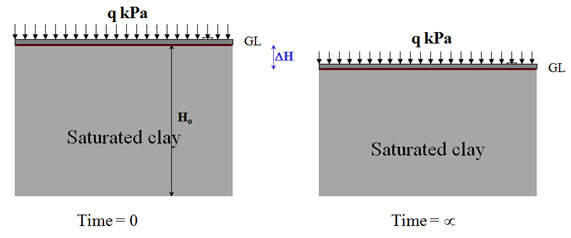Site pages
Current course
Participants
General
MODULE 1. Fundamentals of Soil Mechanics
MODULE 2. Stress and Strength
MODULE 3. Compaction, Seepage and Consolidation of...
MODULE 4. Earth pressure, Slope Stability and Soil...
Keywords
LESSON 21. Consolidation of Soil
21.1 Introduction
When soil is loaded due to the load coming from superstructure, the soil volume will decrease due to the change of particle arrangement in the soil. If both soil particle and water within the soil voids are assumed to be incompressible and soil is completely saturated, then volume change will occur due to the removal of water from the soil voids as a result of externally applied loading. Due to the volume change a downward deformation will take place which causes settlement of the superstructure (as shown in Figure 21.1 and Figure 21.2). The rate of volume change depends on the permeability of soil. Thus, consolidation is a major issue in case of clay due to its low permeability. Consolidation is a time-dependent phenomenon of soil. In the Figure 21.1, the vertical strain e can be written as:
\[\varepsilon={{\Delta H} \over {{H_0}}}\] (21.1)
where H0 is the initial thickness of the soil and H is the change in thickness. From the phase diagram (as shown in Figure 21.1), the vertical strain can be written as:
\[\varepsilon={{\Delta e} \over {1 + {e_0}}}\] (21.2)
where Δe is the change in volume of void (or change in void ratio) due to the removal of water from soil pores, e0 is the initial volume of voids (or initial void ratio). The volume of solid is considered as 1. Thus, volume of voids is e (void ratio, e = volume of voids/volume of solids). The vertical settlement of the soil due to consolidation can be written as:
\[\Delta H={H_0}{{\Delta e} \over {1 + {e_0}}}\] (21.3)

Fig. 21.1 Consolidation of saturated clay

Fig. 21.2 Phase diagram of consolidation of saturated clay
21.2 Settlement of Soil
The total settlement of the soil is the summation of three settlements (i) immediate settlement (ii) primary consolidation settlement and (iii) secondary consolidation settlement or settlement due to creep. Immediate (or elastic) settlement occurs almost immediately after the loading is applied due to the distortion of the soil without any volume change due to removal of water. The time–dependent settlement due to the removal of water from a loaded saturated soil is known as primary consolidation settlement. The primary consolidation depends on the permeability and compressibility of the soil. Some soil (such as peat or soft organic clay) shows time-dependent settlement under constant effective stress during the post primary consolidation period. The settlement during post primary consolidation period is known as secondary consolidation settlement or creep. Thus, the total settlement (St) can be written as:
\[{S_t}={S_i} + {S_c} + {S_s}\] (21.3)
where Si is the immediate settlement, Sc is the settlement due to the primary consolidation and Ss is the settlement due to the secondary consolidation. In general for granular soil, St = Si.
21.3 Factors Affecting Consolidation
The following factors affect the consolidation:
Type of soil
Stress history
Effective stress
21.4 Comparisons between Consolidation and Compaction
Compaction is almost an instantaneous phenomenon, whereas consolidation is a time-dependent phenomenon. In case of consolidation soil is always saturated, whereas in case of compaction soil is always unsaturated. Consolidation is the reduction of water voids, whereas compaction is the reduction of air voids. For compaction specified compaction techniques are used, whereas consolidation occurs due to application load on the soil.
References
Ranjan, G. and Rao, A.S.R. (2000). Basic and Applied Soil Mechanics. New Age International Publisher, New Delhi, India
PPT of Professor N. Sivakugan, JCU, Australia.
Suggested Readings
Ranjan, G. and Rao, A.S.R. (2000) Basic and Applied Soil Mechanics. New Age International Publisher, New Delhi, India.
Arora, K.R. (2003) Soil Mechanics and Foundation Engineering. Standard Publishers Distributors, New Delhi, India.
Murthy V.N.S (1996) A Text Book of Soil Mechanics and Foundation Engineering, UBS Publishers’ Distributors Ltd. New Delhi, India.
PPT of Professor N. Sivakugan, JCU, Australia (www.geoengineer.org/files/consol-Sivakugan.pps).